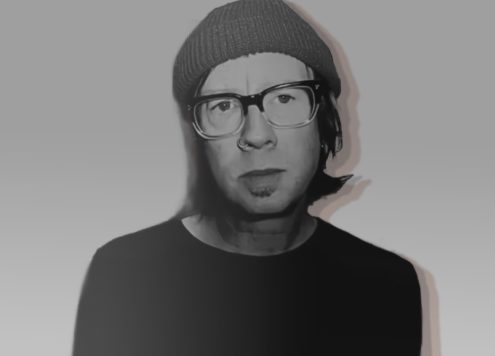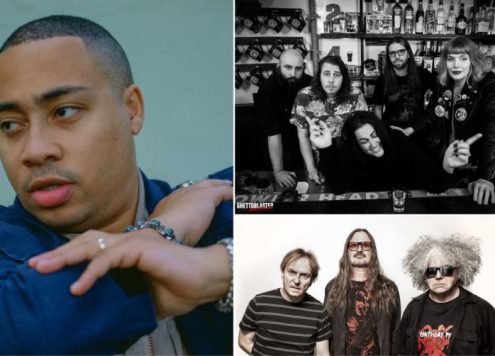How Do You Define Survive?; An interview with Jon Kilian and Chris Pierson of Marmot vs. Mammoth

Marmot vs. Mammoth (MvsM) is a band that wears its influences proudly, though those influences are broad and expertly melded, and you may not initially recognize them. Imagine the rosters of stalwart ’90s labels Touch & Go, Dischord, and Swami. Toss in some post-metal and hardcore, followed by AC/DC and Black Sabbath. Oh, and The Meters, too. What results is a post-punk Fugazi/Shellac-like precision mixed with more expansive metalstyle arrangements, topped with angry early punk vocals that rage against The Man and societal ills.
This melding is not forced. It is the product of many years spent playing together in many bands, and shared musical passions. Chris Pierson (bass) and Jon Kilian (drums) have known each other for 30 years, since they met in second Grade in Akron, Ohio. Aaron Semer (guitar) has known them for almost 20, since their freshman dorm at Ohio University. Throughout this time, various musical projects have come and gone in both Ohio and Seattle, in various formations, with various other people. But it kept coming back to the core of Pierson, Kilian, and Semer, three men who grew up together and vastly expanded and influenced one-another’s musical tastes and playing. It is only natural they eventually formed MvsM.
After trying a couple different singers and formations, Michael Serpe (vocals) forced his way into the band after witnessing a very early performance of MvsM and insisting he was the missing element. Turns out he was right. Serpe’s lyrics and wild, unhinged, live performances brought just the right element of chaos to the churning rhythmic precision of the MvsM sound.
Based on the power and energy of their live shows, MvsM decided to record this album as live as possible. “Greedy” Greg Williamson (Sunny Day Real Estate, Jeremy Enigk, Greedtone, etc.) and The Kill Room in Seattle were chosen to record and mix the album due to the live nature of the room and Greg’s ability to capture bands as they sound. Multiple takes of each song were recorded over two days, and the best takes were selected to be cleaned-up and mixed. Very minimal overdubs were added.
MvsM wanted the record to be as handmade and personal as possible. The vinyl was pressed by a small company in Ohio called Musicol, and all of the covers were designed, printed, and numbered by hand by Michael Serpe.
As with all Heathen Call releases, a portion of the proceeds from each release goes to support a charity of the artists’ choice. For this release, 10 percent from each purchase will go to support YouthCare – www.youthcare.org.
Ghettoblaster recently caught up with Kilian and Pierson to discuss lifelong friendship, Akron, Ohio, and the importance of art and packaging to their music. This is what they said.
Several of you guys have known each other for almost a lifetime. How long had you been making music together before MvsM?
Jon Kilian: Chris and I have been playing in bands together since we were 16. These included many bands you’ve never heard of like Manifold, Lopan, Jazazz, Solyoni and Calmer Than You Are. The best part about growing up together and playing in bands together is that we went through the same phases together. Manifold was punk rock. Lopan was emo-core. Jazazz was an experimental percussion band borrowing heavily from Neurosis. Solyoni was a collective band heavily influenced by Beck and Ween. Calmer Than You Are was an experimental band borrowing heavily from Mogwai and Do Make Say Think. Basically what I am saying is we have been playing in bands all of these years perfecting our own style and borrowing from other bands/genres that we’ve discovered together, and Marmot vs Mammoth is basically a culmination of all of those prior bands. Chris and I met Aaron our freshman year at Ohio University at Read Hall. We did not play in a band with him until I moved to Seattle and drummed for his singer-songwriter band the Plains. Even the name of the Plains comes from the name of a southern Ohio town. Chris, Aaron, and my dorm was an all male dorm respectively named ‘Weed Hall’. We touted the lowest GPA of all dorms at OU. We basically met Aaron because he wore a Fugazi shirt and blasted Tom Waits from his room.
Aaron recorded and played guitar on the albums for Solyoni, CTYA and the first MvsM album, which sounds completely different. Aaron understood right away what these bands were going after. So, when MvsM’s first guitarist left Aaron was the obvious replacement.
Chris Pierson: Jon and I have known each other since the second grade at St. Sebastian in West Akron. Our first experience playing music together was actually in the St. Sebastian marching band – we both played drums. At some point we figured out that we could insert the drum line they taught us to “The Saints Go Marching In” into just about any song they played and it worked fine. I don’t think we lasted much past the fourth grade in that role, and probably gave our music teacher a few extra grey hairs in the process…
Our first band was called Manifold. We played mid-90s style emo punk. We were probably 17 or 18 years old. We had started going to local punk and hardcore shows around Akron, Cleveland, and Kent about a year earlier. We were really into bands like Harriet the Spy, Grain, Armstrong Secret 9 – bands that were part of the Donut Friends Family. Our good friends played in a band called Ligod (who went onto form Pankration and the Phelps Hex), and we played a few shows with them.
Since then Jon and I have probably played in five or six different bands together. After he and I moved out to Seattle (which wasn’t planned, by the way), we re-connected with Aaron and started playing music together. We knew Aaron when we were in school at Ohio University in Athens Ohio but never really played music together (though we certainly supported each other as much as possible). Jon and Aaron played in a band called The Plains (which had an indie rock/Americana sort of feel) and we all played in a pop-punk band called Solyoni, which was the brainchild of our friends Dan Lurie and Dominic Aulisio. Aaron also recorded and produced a record of another band Jon and I were in, Calmer Than You Are, before Jon and I formed Marmot vs. Mammoth.
How did growing up in Akron help shape your musical upbringing and development?
JK: The answer Akronites usually give to this question is, there was nothing else to do besides be in bands and throw rocks at trains growing up in Akron. The real answer is that we grew up in West Akron (a safe, mostly Caucasian suburb) and thought skateboarding and being in punk bands was rebelling against the boring safeness of our upbringing. This idea spilled over into high school where we fit into the freak/jock grouping.
I was in a cover band with the prom king/football star because we both liked Dinosaur Jr. Akron bands would basically compete/borrow from Kent, Ohio bands. Kent is a university town most famous for protesters dying in a Vietnam protest. This perceived competition between us forced us to actually practice our instruments and write actual songs. Akron’ites like to think we won the “competition” because we have more famous musicians to speak of: Chrysie Hynd, Devo, the Black Keys…. etc. But the truth is that growing up, Kent bands like Harriet the Spy, Party of Helicopters, and other bands from that scene really influenced our style and became pretty intertwined with the group of friends and musicians we developed in high school.
Aaron grew up in Fremont, Ohio (Toledo to people outside of Ohio). It is much smaller than Akron so Aaron didn’t quite have the same outlet to local music scenes that we did growing up in Akron, but there was a similar quest to beat the boredom which led him to playing and recording music. Aaron, Chris, and I have been close friends for twenty years. This has helped MvsM grow in quality because we are very comfortable critiquing each other’s parts. We don’t take it personal so are able to adapt our parts for the sake of a more cohesive, tight, and all-inclusive sound. I once asked our previous singer, “How do you survive in this band with us three assholes.” He appropriately responded with, “How do you define survive.” Needless to say he eventually quit the band. Michael Serpe fits right in with our critical style.
CP: Akron is a pretty special place. We are really lucky in that we developed some strong friendships with people, many of which go back to grade school, that are still strong now despite the fact that we don’t live there anymore. There is a really strong music culture that stretches around northeast Ohio (Akron, Kent, Cleveland) that we and our friends fell into growing up. Those friendships that we’ve developed and maintained also really influenced how we developed as musicians.
When was MvsM conceptualized?
CP: We started M vs M with our friend Jose Sandoval, who was also in Solyoni, ‘cause we wanted to have an excuse to play heavy rock music. Solyoni was a lot of fun but was very pop-oriented, and Jon and I both really wanted more of an outlet to play heavy. This was probably around 2007 or so. Jose didn’t last too long and we brought our friend Billie Stultz (another Akron transplant) in to play guitar, and Dominic from Solyoni sang. Aaron produced and recorded our first five-song demo, and even wrote a couple of extra guitar lines for the demo.
The nice thing about playing with Jon for so long is that he and I have developed our own way of communicating when it comes to music, which I think has helped us maintain a certain style and sensibility. We are very rhythmically oriented (it helps that we also make up the rhythm section) and usually start writing songs around a particular rhythm or bass riff. Rarely do we come at it with a whole song in mind, though. At first it led to some pretty choppy song structures – parts piled upon parts – but over time I think we’ve gotten better at refining how we write.
M vs M has always very much been a product of the different personalities in the band. When Jon and I were playing with Billie and Dom, it had a much darker, slow, almost ambient feel with heavier overtones. Once Aaron joined the band he brought a lot of energy and a really good ear towards song structures, which helped us keep the songs shorter and more accessible. Aaron has played with us for long enough and also recorded so many different earlier musical projects that he was already pretty well acquainted with how we work. Now we sort of trade off between starting a song with a really strong guitar riff that we build a song around, and a strong drum and bass rhythm that Aaron can work into.
How has the additon of Michael Serpe changed the direction of the band?
CP: Jon, Aaron and I played together with Dominic for about two or three years. A lot of the same songs we recorded and now play out with Michael were written while Dom was in the band. Dom is an incredibly talented writer and lyricist, but approaches music from more of a singer-songwriter perspective, which ultimately didn’t really work for what we were doing. I think as songwriters we tend to think of vocals last, whereas all of Dom’s earlier work put lyrics and singing in the forefront. We did play out together a handful of times, and Michael was actually at our first show at the Victory Lounge in Seattle. This was around mid-2012. We asked him to come hang out at a practice sometime around the end of that year. We gave him a couple of rough recordings we did in a basement so he could come prepared, and he really went lights out when he showed up for that first practice.
Michael brings a lot of high energy to the band. I wouldn’t say his addition changed the direction of the band per se, but I would say that we play our songs with a lot more aggression and energy than we did before. Michael is originally from Tuscon and played in some old punk and hardcore bands when he lived there, but hadn’t played anything remotely close to M vs M for quite a while. He really tapped into that old energy when he started playing with us – I remember our first practice together we talked about how we played the songs way better than usual with him in it because of the energy that he brought. One thing that we were able to do with Michael that we couldn’t do before was to add backing vocals, which was something that Aaron and I always wanted to do but it never really felt right.
What would you say your predominant influences are?
CP: Mid-90s post-punk and heavier rock/metal are definitely up there. I think we all list Fugazi as a major influence, with a healthy dose of bands like Shellac, Drive Like Jehu and Rodan. I know a number of people have made comparisons to the Jesus Lizard, particularly with Michael’s vocals, which I think is fair.
Michael and Aaron are both huge AC/DC fans, which I think is a good reference point for some of the energy that they both bring to the music. Black Sabbath is another big influence. Aaron, Jon and I all are fans of The Meters, and have always wanted to write super tight, rhythmic songs like those guys did.
Is your forthcoming release your first? How did that come together?
CP: I mentioned earlier that we had recorded a five-song demo when the band was me, Jon, Billie, and Dom. Aaron recorded that one in a friend’s photography studio in Capitol Hill. It’s a good snapshot of what that band was like then, but it’s way different now.
We were really happy with how the songs came together with Michael and knew that we wanted to put a little more time and effort into getting a really good recording, while they still felt fresh. We were really interested in going into a studio this time around – everything else we had done was very DIY – in someone’s basement, in a friend’s studio, etc. Michael connected us with an old friend of his, Greg Williamson, who co-owns a studio he built himself in the industrial part of the city, called Georgetown. The Kill Room is the name of the studio – it’s a big warehouse with tons of space. I think at first we were a little concerned it would be too big of a space, but it was actually perfect. It was the first time that any of us had ever recorded all of our songs totally live – we had always done separate tracks before, so this was a nice change of pace. Very comfortable and natural feeling, which I think came out in the recording itself. We’re really happy with it.
You guys have a pretty iconic logo. Who came up with that and how important is art and packaging to the product you deliver?
CP: Thanks. Our friend Brendan Condit came up with the design. Brendan is an immensely talented animator who likes to draw animals a lot, and I just had a feeling he’d be able to do something cool. He’d never really done anything quite like it before, so I know it was a bit of a challenge for him, but we’re all really happy with how it turned out.
Regarding art and packaging, it’s very important to the ultimate product we put together. We’re self-releasing our album on Michael’s label, Heathen Call. Heathen Call is a boutique record label that specializes in hand crafted, limited edition releases by a variety of musicians. Michael is a screen printer and visual artist, and he puts a lot of thought and care into every release that he puts out. The Heathen Call website has a few videos up that gives you a better sense of Michael’s process and the time and care he puts into each release.
The other cool thing about Heathen Call is that every release sets aside a certain portion to support a charity of the artist’s choosing. Aaron, Jon and I have all worked (or currently work) with homeless populations and at-risk youth. We chose to support a local organization, YouthCare, which does a lot of really great work with homeless youth. You can check out their website here.
Aaron also found a woodcut artist from the early 20th century, Lynd Ward, that we’ve used for just about every flyer we’ve put together since we started playing shows as our current ensemble. His work is really striking and shares a bit of an affinity with the tone that we’re trying to set in our music. Heavy patterns that are a little disturbing and maybe a little violent; something that will definitely stay with you if you spend some time with it.
What have been your favorite performances to date?
CP: We don’t really have a ton of performances under our belts – Jon and I both have two kids each so it’s a little hard to play out more than about once every six weeks or so. But, I think our last show may have been my personal favorite. We played with a local band called Stereo Creeps at a bar in South Seattle/Georgetown called Slim’s Last Chance. It’s got a bit of a biker bar vibe and they serve some of the best chili in town. Stereo Creeps is a lot of fun – pretty heavy, good energy, and good guys overall…
What is next for the band?
CP: Right now we’re mainly focused on releasing the record and playing out as much as possible, really trying to raise as much of a profile for the record as we can, especially with it being a self-release. You can buy it on the Heathen Call website as well as our bandcamp page. We’re also starting to write some new songs and pick out a cover song or two to add to the repertoire.
(The band release their debut on June 30, but have a vinyle release show at The High Dive in Seattle, Washington on Friday, June 26. Marmot vs. Mammoth here: http://marmotvsmammoth.bandcamp.com.)












Social Media